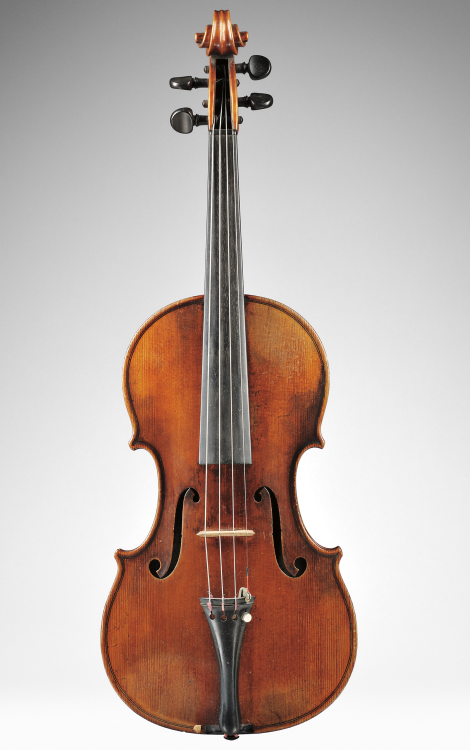
November 6, 2011 Fine Musical Instruments auction Lot 22: Markneukirchen Violin, Paul Knorr, c. 1930, Est. $4,000-6,000
Auction is an excellent avenue to consider when searching for a great value in your next instrument or bow. Fine musical instrument auctions are where the dealers buy. They are, essentially, the wholesale market for the trade. But, these auctions are free and open to the general public.
Auction houses, for their part, have made greater efforts to serve the needs of retail instrument buyers and will show many instruments and bows in ready playing condition. A little known fact is that potential bidders may arrange to take instruments overnight to play in a concert hall, at home, or for their teacher.
Potential bidders can also receive expert advice on condition and authenticity and reputable auction houses are usually quite conservative in their pricing and attribution. Musical instrument experts will be careful to explain the provenance of the instruments, which instruments are guaranteed to be authentic, and which have a traditional or “legacy” attribution with which they may not agree.
With a bit of knowledge and advance preparation, purchasing at auction can be a rewarding way to get an excellent value on your next stringed instrument or bow. It can even open up the possibility of purchasing an antique instrument at a reasonable cost.
Here is my advice for navigating an auction to find the right instrument for you:
1. Do your research
Thanks to the wealth of information online, it’s easier than ever for buyers to educate themselves about the value of antique and contemporary instruments. Ask questions of teachers, other players, dealers and specialists at auction houses and develop an eye for condition and authenticity. Learn which periods, countries, and makers are likely to meet your goals for sound, playability, investment quality, and budget. Find out what similar instruments have sold for, both at dealers and in recent auctions, to establish your budget.
2. Learn when the auctions take place and study the auction catalogues
Most musical instrument auctions take place in the spring and fall. Skinner’s Fine Musical Instrument auctions take place annually in November and May. Once the auction is on the calendar, generally a month prior to the auction date, be sure to order a catalogue or view it online to research what’s available in the sale. This is also a good time to contact the auction house to learn which instruments are good candidates for instrumentalists to consider.
3. Attend the preview and play the instruments
For several days prior to the auction, the general public is invited to view and play the instruments. Seeing, hearing, and playing the instruments is the most important (and perhaps only) way to judge whether an instrument will meet your needs. Private areas are available for testing the instruments. Bring your teacher or another player to help you judge the instruments.
4. Get the best price
Come early to watch the bidding and get a feel for the auction. You’ll know if an instrument is a good find if there is active, competitive bidding for it. As a retail buyer, it isn’t difficult to outbid a dealer, who needs to ensure they have a sufficient margin to mark up the instrument. You only have to be willing to bid one increment more than your competition. And if this bid is still within your budget for the instrument, you’re in good shape. Nonetheless, you should establish your spending limit before the bidding starts so you know clearly when to stop competing.
5. Buying at auction – the details
Be sure you read and understand the terms and conditions of the sale. You will need to agree to these when you register to bid. A standard buyer’s premium will be added to the final hammer price, as will sales tax in certain cases. Make sure you calculate these extra costs into your total budget. Many auction houses also require payment by cash or check.
Once you become accustomed to the layout and organization of an auction, the process becomes intuitive and even thrilling. Once you give it a try, you’ll understand why so many musicians and families of musicians keep coming back to auction to find their next instrument.
Consider Reading : How to Identify an Original Violin Label

I don’t seem to find any place describing how to take part online in an auction. Could you briefly describe. I know how to place a bid, but don’t understand the tracking option.
Thank you for your comment. We offer two online bidding options: absentee bidding and live online bidding through SkinnerLive! Click here for information on how to participate live online in our auctions.
You may place an absentee bid any time up to one hour before the auction using the bid/track button in the online catalogue. Choosing to “track” a lot means that it will be saved to your list of tracked lots. You can access your list of tracked lots at any time here by scrolling to the bottom of the page and selecting “View Tracked Lots Only.”